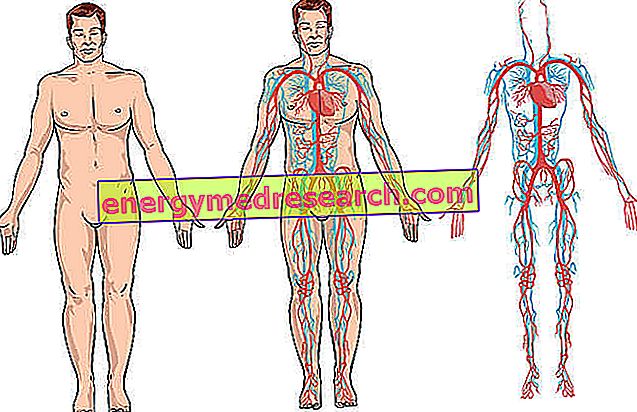Generality
The circulatory system, or cardiovascular system, is the whole:
- of organs and vessels responsible for transporting blood
- of organs and vessels responsible for transporting the sap.
The purpose of the circulatory system is to provide for:
- the survival of the body's cells,
- disease protection,
- body temperature and pH control
- the maintenance of homeostasis.

For the transport of blood, the central organ is the heart: this is comparable to a pump that pushes the blood into the lungs (so that it oxygenates) and then towards the various organs and tissues of the body (so that it gives you oxygen) .
The spread of blood in the various anatomical elements of the human body occurs through the complex vascular network, formed by the so-called arteries, the so-called veins and capillaries.
What is the circulatory system?
The circulatory system, or cardiovascular apparatus, is the set of organs and vessels that allow blood to circulate and transport nutrients, oxygen, carbon dioxide, hormones and blood cells in the direction of and coming from the various cells of the human body, the all with the purpose of providing for:
- The survival of the aforementioned cells;
- Disease protection;
- Body temperature and pH control;
- The maintenance of homeostasis.
The circulatory system is, however, also the network of organs and vessels that have the task of transporting a particular substance, known as lymph .
The network of organs and vessels within which the sap flows is called the lymphatic circulatory system and represents a sub-component of the circulatory system of the human being.
THE HUMAN CIRCULATORY APPARATUS IS A CLOSED SYSTEM
The set of organs and vessels in which the blood of a human being flows constitutes a closed type circulatory system .
A closed circulatory system is a system in which the circulating fluid (in this case the blood) never leaves the organs and vessels that make up the apparatus in question.
Exactly the opposite of what has just been described, the set of organs and vessels in which the lymph of a human being flows constitutes an open type circulatory system .
An open lymphatic circulatory system is a system in which the circulating fluid (in this case the lymph) flows between the cells of the various tissues, like water when it soaks a sponge.
Organization
The fundamental components of the human circulatory system are:
- The blood
- The heart
- Arterial blood vessels or arteries
- Venous blood vessels or veins
- Blood capillaries
- The sap
- Lymphatic vessels
- Lymph nodes and other lymphatic organs
BLOOD
Human blood is a fluid, made up of 55% of a liquid known as plasma and the remaining 45% of cells better known as haemocytes (literally "blood cells").
The plasma is basically a solution containing water, mineral salts and colloidal proteins.
Hemocytes are suspended in the plasma; these belong to three categories of different cells, which are:
- The cell category of red blood cells (or erythrocytes ). Their role is to transport oxygen to the various organs and tissues of the human body and to carry carbon dioxide into the lungs to be expelled from the body.
- The cell category of white blood cells (or leukocytes ). They constitute the immune system and have the task of defending the organism from pathogens and from what can harm you.
- The cell category of platelets . They are among the main actors in the coagulation process.
In the human body of an adult individual, the amount of circulating blood is equal to just over 5 liters, or about 7% of the total body weight .
Curiosity
According to histologists, blood is in effect a tissue (to be precise, a liquid tissue ), because, like any tissue, it is the result of a collection of cells.
HEART
The heart is the central organ of the circulatory system.
It is equivalent to a pump; his job, in fact, is to pump:
- the oxygenated blood in the various anatomical districts of the human body, with the aim of keeping them alive
- the non-oxygenated blood in the lungs, so that the blood itself is loaded with oxygen.
The heart is an unequal organ that is placed in the rib cage, on the left center. Anatomically, it is divisible into two halves, the right half and the left half.
The right half comprises two overlapping cavities, the right atrium, above, and the right ventricle, below.
The left half is very similar to the right half and also includes two overlapping cavities, which are the left atrium, above, and the left ventricle, below.
The heart receives and sends the circulating blood in the human body, through a series of blood vessels:
- The hollow veins (upper and lower), which introduce non-oxygenated blood into the right atrium.
- The pulmonary artery, which branches off from the right ventricle and, dividing into two, carries non-oxygenated blood to the lungs.
- Pulmonary veins, which release oxygenated blood into the lungs inside the left atrium.
- The aorta, which departs from the left ventricle and carries oxygenated blood to the various organs and tissues of the human body.
The heart has a particular muscular component - the so-called myocardium - which, thanks to a network of nerve fibers, unique in its kind, has the ability to self-control.
ARTERY
The anatomists call arteries all the blood vessels that carry blood from the heart to the periphery (where by periphery, we mean the network of organs and tissues).
A characteristic of arterial vessels, which immediately jumps to the eye by observing the image of the human circulatory system, is their progressive reduction in diameter starting from the heart.
In other words, as the arteries move away from the heart, their diameter is gradually reduced.
Unlike many people believe, arteries are not simple inert conduits, but they are dynamic structures, with elasticity and a certain amount of muscle cells that allow them to contract or dilate. At their constitution three overlapping layers of cells participate, known as: intimate habit (innermost layer), medium frock ( middle layer) and adventitia frock (outer layer).
There are three types of arteries: large arteries (or large-caliber arteries or elastic arteries), arteries of medium caliber (or muscular arteries) and small-caliber arteries (or arterioles).
The criteria that distinguish the various types of arteries are, first of all, the size of the diameter and, secondly, the capacity for contraction and elasticity.
| Characteristics of the various types of arteries in the human body | ||
Guy | Description of the features | Main examples |
Large arteries | They have a diameter of 7 millimeters or more and an extremely elastic wall. The high elasticity of the wall allows them to better withstand the strong pressures given to the blood by the heart. |
|
Medium caliber arteries | They have a diameter between 2.5 and 7 millimeters and a strong wall, but not too elastic. They have a low resistance to blood flow. The anatomists define them as distribution arteries. |
|
Small caliber arteries | They are less than 2.5 millimeters in diameter and have a considerable muscular component. Their wall is thick and contractile, which ensures better control of blood flow to the capillaries. |
|
Curiosity: do the arteries carry only oxygenated blood?
It is common to identify arteries such as blood vessels in which oxygenated blood flows.
This is incorrect or, better, only partially corrected. In fact, in the human body, there is a network of arterial vessels in which oxygen-poor blood flows: it is the arterial system constituted by the pulmonary artery and its branches.
The fact that the pulmonary artery and its branches fall into the list of arterial vessels is perfectly in line with the definition of an artery ("all the blood vessels carrying blood from the heart to the periphery are arteries").
VEINS
The anatomists define all the blood vessels that carry blood from the periphery to the heart.
Starting from the periphery and proceeding towards the heart, the venous vessels gradually become larger and larger, exactly like the arteries.
In the periphery, the veins have a diameter of dimensions comparable to those of the capillaries, with which they are in continuity.
Near the heart, on the other hand, they can have a diameter of the order of centimeters: for example, the superior vena cava and the inferior vena cava, which are the two venous vessels placed in connection with the heart, have a diameter of about 20- 22 millimeters (ie 2-2.2 centimeters).
| Main features of veins and comparison with arteries: |
|
CAPILLARIES
Located at the extremities of the arteries and veins, the capillaries are small blood vessels, having the important task of allowing the exchange of gases, nutrients and metabolites between the blood and the cells making up the tissues of the body.
To guarantee the aforementioned exchanges, is the characteristic thin wall of the capillaries: through this, in fact, they can pass - both from the inside to the outside and from the outside towards the inside - gaseous molecules such as oxygen or carbon dioxide, ions of various kinds, nutrients for cells, waste products, water, etc.

Figure: example of artery (in red), vein (in blue) and capillaries (in the center).
Unlike arteries and veins, the capillaries are the result of a single layer of cells, in this case a layer of endothelial cells. Histologically, therefore, the capillaries lack muscle cells and cells typical of the adventitious habit.
LINFA
The lymph is a fluid that comes from the blood and that with the blood has in common different compositional elements.
Transparent in color, straw yellow or milky, depending on the case, the sap contains sugars, proteins, salts, lipids, amino acids, hormones, vitamins, white blood cells etc.
The content of the lymph depends on its contact with the blood, on the interstitial spaces.
LYMPHATIC VASES
Lymphatic vessels are the vessels in which the lymph flows.
Unlike what happens with blood, the passage of lymph inside the lymphatic vessels does not depend on an organ-pump like the heart, but on the smooth muscles of the vessels themselves and on the action of the skeletal musculature (therefore, the movement of the body allows the lymph to flow through the lymphatic vessel system).
Inside the lymphatic vessels, the lymph flows from the periphery towards the center, just like venous blood.
From the anatomical point of view, the lymphatic vessels are connected to a dense system of capillaries, at the level of the interstitial spaces, and present the peculiarity of running parallel to the venous vessels.
The course parallel to the venous vessels ends at the level of the succlavic veins : here, the two most important lymphatic vessels of the human body, the so-called right lymphatic duct and the so-called thoracic duct, are joined, respectively, to the right subclavian vein and to the left subclavian vein and they pour their content into it.
The lymphatic system, therefore, and the blood circulatory system (in this case the venous system) are closely connected from the vasal point of view: this allows the lymph to return to the bloodstream, once performed its functions.
LYMPHONODES AND OTHER LYMPHATIC ORGANS
Lymph nodes are small organs of the lymphatic system, comparable to biological filters, having the purpose of intercepting and destroying any germs, foreign substances or neoplastic cells present in the lymph.
In the human body, the lymph nodes reside in strategic points, such that the monitoring of the lymph is highly effective.

Figure: example of artery (in red), vein (in blue) and capillaries (in the center).
In addition to lymph nodes, they are included in the list of so-called lymphatic organs, as they produce and purify lymph, thymus, spleen and bone marrow.
Functions
We have already spoken of the role played by the circulatory system at the beginning of the article.
In this section, therefore, we will focus on how the blood oxygenates at the lung level, on which is the fetal blood circulation and, finally, on the functions of the lymphatic circulatory system.
BLOOD OXYGENATION
To oxygenate the blood, the circulatory system "works" in association with the respiratory system.
That's how:
- The blood leaving the right ventricle of the heart and directed to the pulmonary arteries flows to the lungs, precisely into the blood capillaries that surround the so-called pulmonary alveoli (or simply alveoli).
- The pulmonary alveoli are small sacs, located at the ends of the respiratory tract and capable of containing the air rich in oxygen which, as a rule, the human being introduces during breathing.
- When the blood reaches the capillaries of the pulmonary alveoli, it begins to draw the oxygen from the air inside the alveoli themselves.
- In exchange for oxygen, the blood releases the carbon dioxide contained in it, deriving from the cellular activity and representing a waste product.This gas exchange (oxygen-carbon dioxide) is called blood-alveoli or hematosis gas exchange .
- As the oxygen is charged, the blood returns to the heart, taking at first the smaller branches of the pulmonary vein and then the pulmonary vein itself (which connects to the ventricle to the left atrium of the heart).
- The blood capillaries of the pulmonary alveoli are the result of the intertwining of the branches of the pulmonary arteries, in which runs oxygen-poor blood and rich in carbon dioxide, and the branches of the pulmonary vein, in which oxygen-rich and poor blood flows of carbon dioxide.
FETAL BLOOD CIRCULATION
Fetal blood circulation takes place in ways that are decidedly different from post-natal blood circulation.
All this is a consequence of the fact that the human being, during his uterine life, does not have the possibility to breathe through the lungs and to oxygenate, in this way, the circulating blood.
The mother is responsible for supplying the fetus with oxygenated blood.
Here's how:
- The maternal blood rich in oxygen reaches the fetus through the umbilical vein : this is in connection with the vena cava of the future unborn child and pours its own content there.As usual, the inferior vena cava ends in the right atrium, therefore the oxygenated blood will reach the heart through a different way from the "canonical" one.
- Once inside the right atrium, oxygen-rich blood flows only minimally into the right ventricle, as it takes up a small opening in between, located between the right atrium and the left atrium and called the Botallo hole .With the direct passage from the right atrium to the left atrium, the oxygenated blood is already ready to enter the aorta and, from there, be distributed in the various organs of the body.
- The small amount of blood flowing into the right ventricle is mixed with blood from the superior vena cava and, with the latter, it takes the pulmonary artery.The pulmonary artery of the fetus has a peculiarity: it is a deviation, called the arterial duct, which connects the pulmonary artery itself directly with the aorta.
In other words, through the ductus arteriosus, even the blood flowing into the right ventricle reaches the main arterial vessel of the human body, on which the oxygenation of the various organs and tissues depends.
FUNCTIONS OF THE LYMPHATIC CIRCULATORY SYSTEM
Briefly, the functions of the lymphatic circulatory system are:
- Transfer the liquid and the proteins filtered by the blood capillaries into circulation
- Transfer absorbed fats to the small intestine in the systemic circulation
- Capture and destroy pathogens foreign to the body, producing and transforming the cells responsible for their neutralization
diseases
The pathologies of the circulatory system are the known and, unfortunately, widespread cardiovascular diseases .
The main cardiovascular diseases include: coronary heart disease (which is a possible cause of angina pectoris or infarct), various forms of arrhythmia, valvulopathies (ie heart valve diseases), various types of aneurysms (ascending aortic aneurysm etc), peripheral vascular diseases (venous thrombosis etc.), stroke, TIA, pulmonary embolism etc.
In this section, some of the main risk factors of circulatory system diseases are worth mentioning: on all, hypertension and atherosclerosis.



